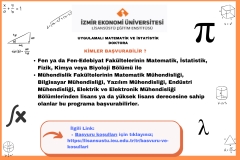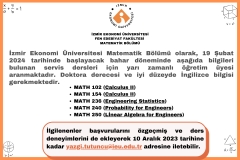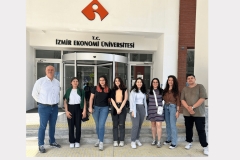
FACULTY OF ARTS AND SCIENCES
Department of Mathematics
RM 403 | Course Introduction and Application Information
| Course Name |
Applied Risk Analysis
|
|
Code
|
Semester
|
Theory
(hour/week) |
Application/Lab
(hour/week) |
Local Credits
|
ECTS
|
|
RM 403
|
Fall/Spring
|
3
|
0
|
3
|
5
|
| Prerequisites |
None
|
|||||
| Course Language |
English
|
|||||
| Course Type |
Elective
|
|||||
| Course Level |
First Cycle
|
|||||
| Mode of Delivery | - | |||||
| Teaching Methods and Techniques of the Course | - | |||||
| Course Coordinator | - | |||||
| Course Lecturer(s) | - | |||||
| Assistant(s) | - | |||||
| Course Objectives | Main objective of the course will be on the essential tools and ideas that will allow students to identify risks, to determine various approaches to quantifying risk and evaluating the effect on corporate strategy, to negotiate the hedge or don’t hedge decision, and in the former case, identify the alternative strategies to accomplishing the hedging objectives. |
| Learning Outcomes |
The students who succeeded in this course;
|
| Course Description | Data and portfolio risk analysis will be learnt by using several approaches. Learning techniques requires an extensive use of Excelbased applications. JP Morgan’s RiskMetricsTM will also be covered during the course as a benchmark source for risk analysis and modeling. |
|
|
Core Courses | |
| Major Area Courses | ||
| Supportive Courses |
X
|
|
| Media and Management Skills Courses | ||
| Transferable Skill Courses |
WEEKLY SUBJECTS AND RELATED PREPARATION STUDIES
| Week | Subjects | Related Preparation |
| 1 | Self Introductions & General Information on the Course | Textbook: Risk Management and Financial Institutions by John C. Hull, ISBN: 9780138006174 |
| 2 | Introduction to Risk Management | Chapter. 1 |
| 3 | Banks, Insurance Companies and Pension Plans | Chapter. 2&3 |
| 4 | Financial Instruments | Chapter. 5 |
| 5 | How Traders Manage Their Exposure | Chapter. 6 |
| 6 | Interest Rate Risk | Chapter. 7 |
| 7 | Value at Risk | Chapter. 8 |
| 8 | Volatility | Chapter. 9 |
| 9 | MidTerm Exam | |
| 10 | Correlations and Copulas | Chapter. 10 |
| 11 | Market Risk VaR – Historical Simulation Approach Market Risk VaR – ModelBuilding Approach | Chapter. 12 & 13 |
| 12 | Credit Risk | Chapter. 14 &15 |
| 13 | Scenario Analysis & Stress Testing | Chapter. 17 |
| 14 | Operational, Liquidity & Model Risk | Chapter. 18 & 20 |
| 15 | Risk Management Mistakes to Avoid & Review for Final Exam (Comprehensive) | Chapter. 22 |
| 16 | Review of the Semester |
| Course Notes/Textbooks | Book Chapters |
| Suggested Readings/Materials | TEXTBOOK: Risk Management and Financial Institutions, John C. Hull, ISBN: 9780138006174 Applied Risk Analysis, Jonathan Mun, 9780471478850 Journals & Magazines Risk Magazine (http://www.risk.net/ , paid subscription required, abstracts available for free) Global Risk Regulator (http://www.globalriskregulator.com , paid subscription required, abstracts and some articles are available for free) The Journal of Risk (http://www.thejournalofrisk.com/) Daily Journals Financial Times Wall Street Journal WebSites (sign up required) GARP (http://www.garp.org/) PRMIA (http://www.prmia.org/) Riskmetrics (http://www.riskmetrics.com/) Bank for International Settlements (http://www.bis.org) Risk Management WebSites http://www.riskworld.com/websites/webfiles/ws5aa015.htm |
EVALUATION SYSTEM
| Semester Activities | Number | Weigthing |
| Participation |
1
|
10
|
| Laboratory / Application | ||
| Field Work | ||
| Quizzes / Studio Critiques | ||
| Portfolio | ||
| Homework / Assignments |
1
|
10
|
| Presentation / Jury |
1
|
20
|
| Project | ||
| Seminar / Workshop | ||
| Oral Exams | ||
| Midterm |
1
|
25
|
| Final Exam |
1
|
35
|
| Total |
| Weighting of Semester Activities on the Final Grade |
65
|
|
| Weighting of End-of-Semester Activities on the Final Grade |
35
|
|
| Total |
ECTS / WORKLOAD TABLE
| Semester Activities | Number | Duration (Hours) | Workload |
|---|---|---|---|
| Theoretical Course Hours (Including exam week: 16 x total hours) |
16
|
3
|
48
|
| Laboratory / Application Hours (Including exam week: '.16.' x total hours) |
16
|
0
|
|
| Study Hours Out of Class |
16
|
1
|
16
|
| Field Work |
0
|
||
| Quizzes / Studio Critiques |
0
|
||
| Portfolio |
0
|
||
| Homework / Assignments |
10
|
1
|
10
|
| Presentation / Jury |
1
|
6
|
6
|
| Project |
1
|
10
|
10
|
| Seminar / Workshop |
0
|
||
| Oral Exam |
0
|
||
| Midterms |
1
|
10
|
10
|
| Final Exam |
1
|
14
|
14
|
| Total |
114
|
COURSE LEARNING OUTCOMES AND PROGRAM QUALIFICATIONS RELATIONSHIP
|
#
|
Program Competencies/Outcomes |
* Contribution Level
|
||||
|
1
|
2
|
3
|
4
|
5
|
||
| 1 | To be able to have a grasp of basic mathematics, applied mathematics or theories and applications of statistics. |
|||||
| 2 | To be able to use advanced theoretical and applied knowledge, interpret and evaluate data, define and analyze problems, develop solutions based on research and proofs by using acquired advanced knowledge and skills within the fields of mathematics or statistics. |
|||||
| 3 | To be able to apply mathematics or statistics in real life phenomena with interdisciplinary approach and discover their potentials. |
X | ||||
| 4 | To be able to evaluate the knowledge and skills acquired at an advanced level in the field with a critical approach and develop positive attitude towards lifelong learning. |
X | ||||
| 5 | To be able to share the ideas and solution proposals to problems on issues in the field with professionals, non-professionals. |
|||||
| 6 | To be able to take responsibility both as a team member or individual in order to solve unexpected complex problems faced within the implementations in the field, planning and managing activities towards the development of subordinates in the framework of a project. |
|||||
| 7 | To be able to use informatics and communication technologies with at least a minimum level of European Computer Driving License Advanced Level software knowledge. |
|||||
| 8 | To be able to act in accordance with social, scientific, cultural and ethical values on the stages of gathering, implementation and release of the results of data related to the field. |
|||||
| 9 | To be able to possess sufficient consciousness about the issues of universality of social rights, social justice, quality, cultural values and also environmental protection, worker's health and security. |
|||||
| 10 | To be able to connect concrete events and transfer solutions, collect data, analyze and interpret results using scientific methods and having a way of abstract thinking. |
X | ||||
| 11 | To be able to collect data in the areas of Mathematics or Statistics and communicate with colleagues in a foreign language. |
|||||
| 12 | To be able to speak a second foreign language at a medium level of fluency efficiently. |
|||||
| 13 | To be able to relate the knowledge accumulated throughout the human history to their field of expertise. |
|||||
*1 Lowest, 2 Low, 3 Average, 4 High, 5 Highest
NEWS |ALL NEWS
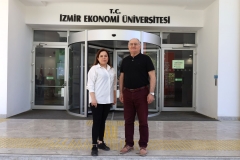
International success in mathematics
Spain-based ranking organization Scimago Institutions Ranking ranked IUE Department of Mathematics as 261st in the world and second in our country, as a
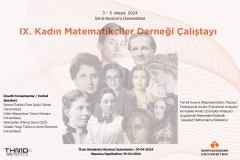
9th Workshop of Association for Turkish Women in Maths
9th Workshop of Association for Turkish Women in Maths will take place from May 03 to May 05, 2024 in Izmir, Turkey,

Our 2009 Graduate Has Been Appointed to the South Marmara Development Agency (GMKA) as the General Secretary
Onur Adıyaman, General Secretary of the Eastern Black Sea Development Agency, appointed as the General Secretary of the South Marmara Development Agency.

Young mathematicians came together at IUE
The award ceremony of the Turkish Mathematical Olympiad, which is organized to increase the interest of primary, secondary and high school students





